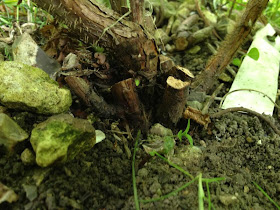There is probably a reason why I did not know Neillia, and it's because there doesn't seem to be much information around about them.
Originally from China, there are 16 species whose name has been accepted in the genus. As it is in the Rosaceae family, there are quite a few specimens in the South Canal beds. Deciduous shrubs, originally from Asia, with arched branches; some of the species are suckering. Leaves are alternate, lobed, ovate to ovate-oblong and toothed, which may turn yellow to red in autumn. Flowers are various shades of pink, borne on racemes, and bloom in late spring to early summer.
After my first encounter with the species, when stock-checking, I came across a label Rhodotypos scandens that was not apparently associated with a plant of that name. I researched online on the Missouri Botanical Garden website and there was definitely no Rhodotypos around. I was pretty sure there was an unlabelled Neillia there, though...
... and, again when stock-checking another day, I came across another Neillia, a puny rubiflora that looked surrounded by weeds. On closer look, there was a Prunus of some sort poking out from its back... given that I always have my secateurs on me and that I cannot stand stumps I cut the Prunus so it stood out as an eyesore for me to notice next time I was doing weeding.
By the way, stumps are not only ugly from an aesthetic point of view: it is bad horticultural practice to leave random bits of wood when pruning, as they will die back and possibly act as the entrance point for diseases and fungi such as coral spot.
Pruning is best done:
- close to - just above - a node (where leaves and buds are located on a stem); you should make sure there is strong and healthy outward-facing bud that will grow without congesting the plant; nodes are a region of the stem where healing is easier for the plant;
- next to a branch collar*, making sure not to cut into it, because collars are natural protection areas of the plants and callus forms quicker there;
- right down to the ground**.
 Anyway, my devious strategem worked, and, today, while weeding I spotted the stump straight away and set about to free the poor Neillia of the intruder... well, actually, it turned out to be intruders - plural...
Anyway, my devious strategem worked, and, today, while weeding I spotted the stump straight away and set about to free the poor Neillia of the intruder... well, actually, it turned out to be intruders - plural...
 |
| a Bryonia dioica |
 |
| the Prunus |
 |
| a Crataegus |
 |
| ... and a Sorbaria |

... a red bryony, Prunus, Crataegus and Sorbaria later... it became apparent it had become a bit overcrowded around there, as the Neillia had obviously escaped attention. Anyway, all sorted now, we should have a happier plant!
NOTES
*A branch collar is the ridge that a branch forms where it joins the stem. A fantastic colleague taught us that the collar is still part of the main stem, from which the branch emerges (it originates where a bud was sited, fed by a branch in the vascular system deep inside the stem). When you cut the branch, you should not cut into the main stem: that way, the wound will heal quicker, and, ideally, in a number of years, be completely covered by the stem's bark. Below a few pictures:
 |
| A branch collar: the ridge is visible from which the branch emerges |
 |
| Branches originating from inside the stem |
 |
| A good pruning wound being covered by bark |
 |
| The black stain in the section shows where a branch was not correctly pruned: the stem did not find it easy to heal the wound |





hello what is a branch collar ? and right down to the ground, is that to soil level? obvious questions probably. I am hopeless at pruning xx
ReplyDeleteJoanna, I have added notes to the post with a few pictures more than I shared already. Do let me know if there is still anything I could explain better please.
ReplyDelete